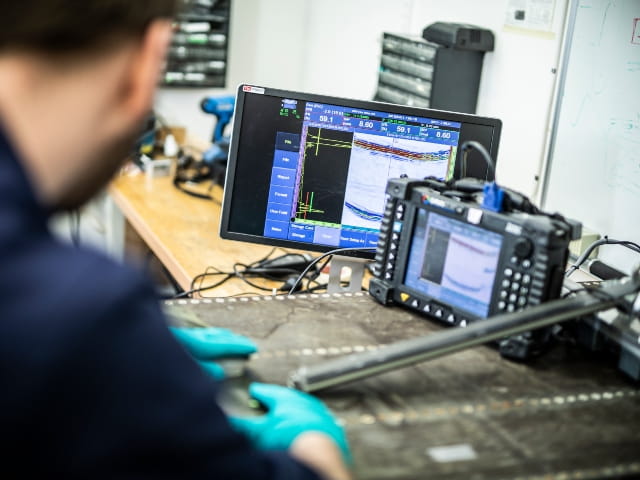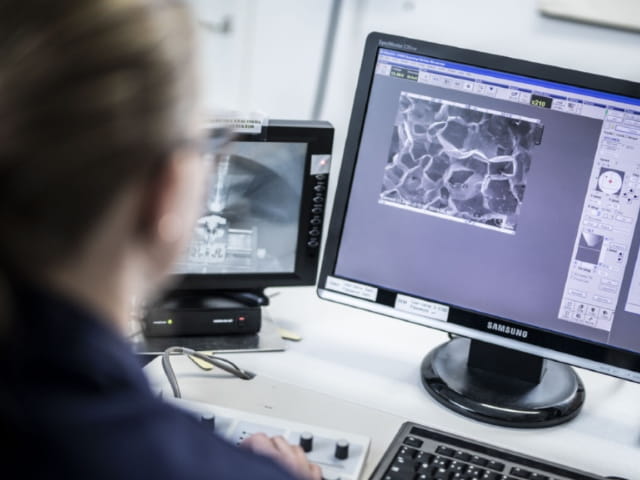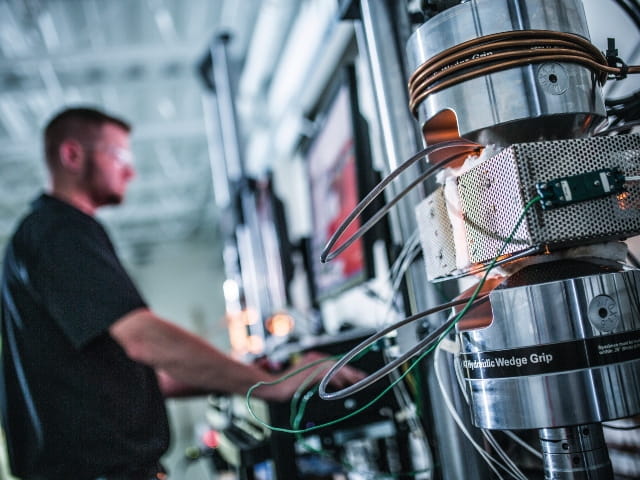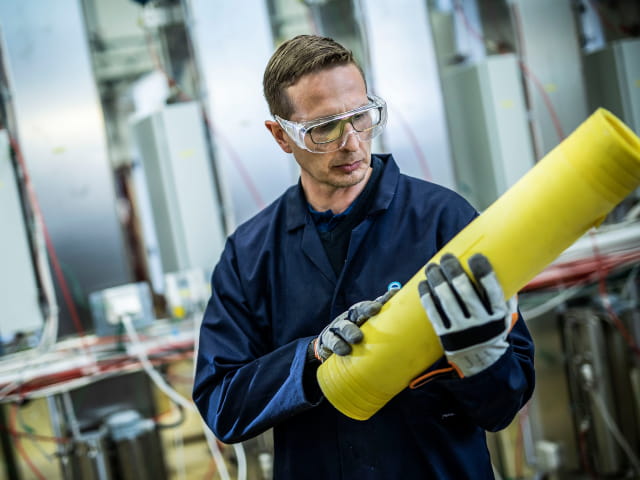Qualification of the Properties of New Composite Materials
Composite materials provide product manufacturers with a number of potential advantages over more traditional materials. Made from two or more different materials that, when combined, are stronger than those materials individually, composites are typically designed with a specific use in mind. Their extensive range of benefits includes increased strength, decreased weight, superior efficiency, durability, and greater design flexibility. They also have the ability to be well suited to harsh, toxic environments due to their non-conductive and corrosion-resistant properties.
Typically, a fiber reinforced composite will comprise a fiber material such as glass or carbon combined with a matrix such as polyester, epoxy, or vinyl ester. Carbon fiber reinforced composites (CFRPs) are predominantly used in more technically onerous applications and heavily regulated industries such as aerospace, while glass-reinforced polymer composites (GRPs) are more frequently used in less technical applications such as wind technology.
The aerospace sector has been using composites for their enabling properties for many years. Element is now increasingly assisting customers from other industries in using composites as key enabling materials in new applications. A composite’s property, for example, to be extremely lightweight offers huge advantages for low-emission electric vehicles, while a corrosion-resistant, buoyant composite can transform oil and gas platforms that have historically been designed using steel.
Determining the properties of new composite materials
When any new composite material is developed, it requires much more testing than a traditional material that has been in use for many years. The properties of the new composite need to be carefully determined through qualification testing in a variety of different environmental conditions involving multiple specimens.
When manufacturing a new part using a traditional material such as a metal, very little test result data is needed to prove all the required properties that design engineers require to show the part is fit for purpose. This is because the behavior of metals is very well understood over their many years of use.
While composite materials can offer significant advantages to designers and manufacturers, composites’ material properties are, unlike metals, non-isotropic, meaning the properties are not the same in all directions. They can exhibit very different responses to applied forces, which may vary significantly depending on the load and environmental conditions to which the composite material is exposed. Therefore, it is critical to have complete confidence in how the composite material will behave during its proposed use. The only way to achieve this is by testing extensively to build up the necessary bank of test data and provide all the test data required to manufacture a new part within the prescribed safety parameters.
The composite material will have to be extensively tested by the raw material manufacturer and, once it is purchased, by the product or parts manufacturer. A raw material inspection will need to take place on arrival at the manufacturing plant to ensure it has not been affected by transportation. As composites usually only have a six-month lifecycle, if the material has not been used in production within that timeframe, it will then need to be re-qualified. The certification process required before the new product or part using the composite material can be put into production will also demand extensive testing. Finally, testing for ongoing production control purposes will also be necessary.
Composite material testing
The qualification process for any new composite material will encompass a range of both mechanical and physical test methods to evaluate its strength and durability and ensure it is fit for purpose.
Mechanical testing
The mechanical tests, which are dependent on the geometry of the test sample used, fall under three key categories: tensile, compression, or shear.
Tensile and compression testing include plain tests used to generate data on the pure loading mode, open-hole (notched) tests, and filled-hole tests which are used to replicate in-life behavior where the material may require the installation of fasteners or bolts that may affect the life of the material. These tests can also be used to simulate a flaw in a material component. Flexural tests can be utilized as an alternate or supplementary testing procedure to consolidate the tensile and compressive mechanical properties further.
Shear testing includes in-plane and out-of-plane (interlaminar) shear tests. In-plane shear (IPS) tests utilize a tensile test setup to generate shear loading in fibers oriented at +/- 45° to the direction of the test. Interlaminar shear strength tests (ILSS) are used to determine the shear strength between the lamina and can also provide information on the degree of cure in relation to the fiber-matrix adhesion.
In addition, Element’s series of fracture toughness tests show how the development of cracks or delamination can influence material properties. Mode I tests show the behavior of cracks opening and extending, while mode II tests are used to generate data on crack shear behavior and mode III on crack tearing or twisting. Additionally, compression after impact (CAI) tests are able to show the degradation of the material’s mechanical properties after a controlled impact.
Element also provides an extensive range of other mechanical tests, including lap shear testing; climbing drum peel (CDP) testing; bearing testing; corner bend testing; and fastener pull-through testing to identify the weakest parts of a composite’s structure.
Physical testing
Physical tests are critical to fully characterize a new composite material’s behavior and, unlike mechanical testing, are not dependent on the geometry of the material. Element offers the full range of physical testing required for material qualification and certification, including:
- Constituent content testing to quantify the percentage of fiber and resin across the new material. This can be determined, as well as the void content, using acid digestion or a burn off test, depending on the material to be tested.
- Dynamic Mechanical Analysis (DMA) testing to determine the glass transition temperature using DMA (dynamic mechanical analysis) provides information on the safe upper working temperature of the part.
- Differential Scanning Calorimetry (DSC) testing and other thermal transitions to characterize the degree of polymer cure using DSC, as well as other important thermal transitions such as Tm (melting temperature) or Tc (crystallization temperature), if present.
- Fourier Transform Infrared analysis (FTIR), is a technique that uses infrared light to scan test samples and observe chemical properties.
- High-Performance Liquid Chromatography (HPLC) testing to identify, quantify and separate the different components of a composite.
Examining the microstructure of the new composite
When qualifying new composite parts, it is important to analyze the material’s macroscopic and microscopic properties. This enables the identification of issues such as unnecessary wrinkles, resin-rich areas, ply drops, cracks, or delamination. Using this technique, it is also possible to quantify the percentage of porosity, also known as void content, present. This is key due to the strict limitations regarding how much of a sample is allowed to be porous. Microscopy can also be utilized to further examine the failure modes of some of the more complex mechanical test failures.
Establishing the effects of long-term physical aging
In conjunction with the physical and mechanical tests, it is also essential to fully understand the effects of long-term physical aging of the composite parts when in service. Over time the material could be exposed to a variety of environmental factors, such as continuous hot/wet conditions, which could plasticize the material and cause a decrease in the composite strength and fiber/matrix interface. Element can help accelerate this aging process in a controlled environment, and the resultant testing of the post-conditioned samples can be used to show the ‘worst case’ test results.
When this testing is combined with testing of pristine, room temperature test samples and also a range of samples tested at sub-ambient temperatures, it is possible to build a full picture of how the material will behave in all conditions, ensuring the manufacturer has everything they need to sign off the part for service. Element can also help manufacturers to understand the material effects of exposure to other conditioning environments, including cleaning fluids, hydraulic fluids, and fuels.
Taking a complete lifecycle approach to composite testing
Element provides a whole life cycle approach to composite testing, offering guidance from the project’s inception during the early design and research & development (R&D) stages of the composite manufacturing process through to maintaining quality and consistency, failure analysis, and final completion. This includes the critical support required to navigate and interpret the nuanced complexities of the various test standards.
Working out of our ISO 17025 accredited state-of-the-art composite testing laboratories, Element provides the full range of mechanical and physical testing needed to prove that a part is fit for purpose. This includes capabilities to physically age specimens to compare ‘best case’ and ‘worst case’ test results and non-destructive testing (NDT) to gather information on any manufactured or accidental defects.
Our team’s wealth of experience working on R&D projects, first part qualification (FPQ) projects, raw material qualifications, and bespoke test projects ensure Element can provide expert advice on the most suitable way to perform a proposed test schedule and ensure accurate, reliable results.
Taking expert advice in the early stage of the test campaign’s definition can be hugely beneficial, saving time and money. Our composite experts work closely with the manufacturer in preparing to test, helping to clarify issues such as which test standard could best prove the properties of interest to whether all the necessary test types have been sufficiently covered in order to prove the part.
Ensuring a smooth sample preparation process
As part of the sample preparation process, Element helps to ensure that the proposed test samples being used are of the most suitable geometry and are being taken from the most appropriate locations and directions as well as being sampled at the best frequency. Our team will also help establish the best way to machine and prepare these samples prior to the test.
Element’s access to an accredited machine shop enables the extraction, machining, and preparation of test samples in line with the requirements of the relevant test standards, including the ability to apply end tabs and strain gauges if required. We also manufacture and repair composite test panels in line with the customer’s instructions.
For more information on composite testing, please contact us.
Find related Resources





